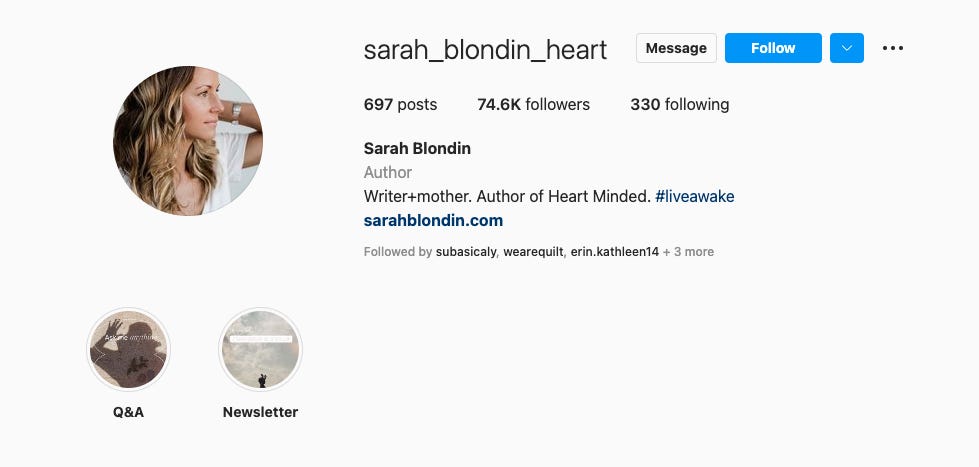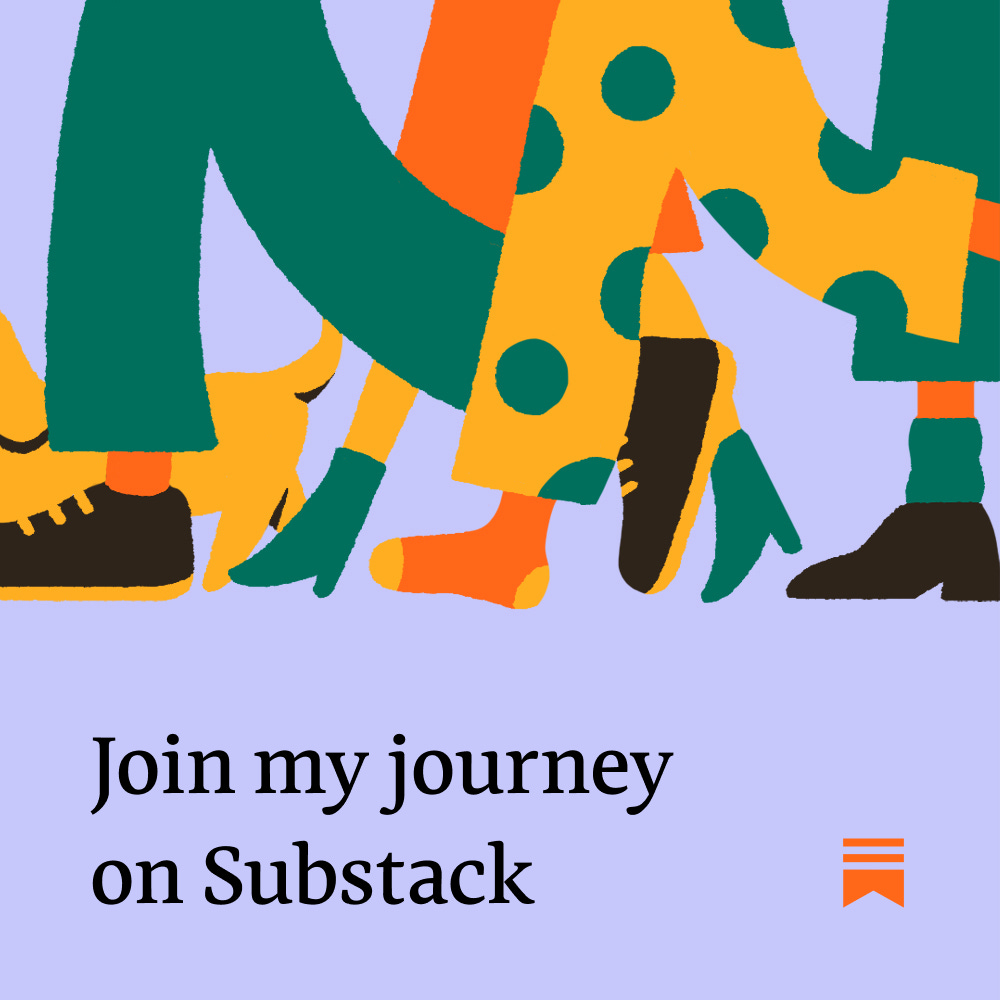Getting started on Substack: A guide for Instagrammers
Tips to get started from writers big on Instagram who are taking back control of their audience
Step 1: Set up your account
When setting up your Substack publication for the first time you will be prompted to pick a publication name and URL.
Our in-house SEO experts often encourage those with a substantial following elsewhere to use their name as their URL, then choose something memorable for the publication name. The main thing is to pick a title and URL that is memorable and searchable.
You’ll be asked to create a one-line description. This is what visitors see when they land on your Substack site for the first time. A great one-liner clearly and concisely highlights what your publication is, and what differentiates it from the other newsletters out there.
Here are a few examples:
In Pursuit of Clean Countertops
sarapetersen.substack.com
Unpacking my obsession with momfluencer culture to destroy the myth of the perfect mama.The Unpublishable
jessicadefino.substack.com
What the beauty industry won't tell you, from a reporter on a mission to reform it.Dinner, A Love Story
dinneralovestory.substack.com
A newsletter devoted to the family meal, however you define “family” and however you define “meal.” Written by the NY Times bestselling author of the Dinner: A Love Story book series including, most recently “The Weekday Vegetarians.”
Watch: How to start a Substack as you set up your account.
Why Substack: Free speech and support structures
“One of the reasons I choose Substack is they vehemently support free speech. And respect their writers. They have actual conversations and communication about the content shared. And, there are real people behind their customer service. Unlike here.”
— Jessica Reed Kraus, House Inhabit (Instagram, 1M followers)
Source: Instagram story
Step 2: Craft your first post
Share a post for new readers to land on. When crafting your first post, you might think of it like a manifesto—a public declaration of why you are sharing your work here.
Include your personal story, explain why you are here, and outline your hopes for how you will use the space. Consider this a conversation and prompt your new readers to engage with the post in the comments. Don’t forget to include a subscribe button or two.
Examples of first posts:
Lisa Oliver starts with a header, paired with a button, that cuts straight to what her Substack will offer: “Human Stuff is a free weekly newsletter. If you’d like to create reciprocity for my work and also access my monthly audio recording, q&a, & journaling guide, I invite you to become a paid subscriber. Your support means so much.” Then outlines what will unfold in the rest of the post: “The purpose of this first letter is to introduce myself, share why I am here, and give you some insight on the journey to starting this space and what to expect moving forward.”
Sarah Wilson explains her why for being on Substack: “The world needs deeper, more intimate, nuanced, and mindfully curated information.”
Yung Pueblo outlines what the newsletter space will look like: “I want to use this platform to expand creatively and allow myself more space for experimentation and depth.”
Finding your value
“There was a time when I gave away a lot of myself here. You really COULD talk about things, with nuance, and length. But now it’s all about reels, and that’s fine, but this isn’t really feeling like the place for me, as a writer. Because first and foremost, that’s what I am. A writer. Not a brand, not a content creator. Not a meme maker. I like writing lots of words, and I have been left increasingly wondering where to put them. The personal words. The unpaid ones. The deeply honest and direct ones. Where do my words belong where they feel safe and valued?
“So I am starting a Substack. There I hope to connect more with the people who read my words. Build a little community. One based on interest and connection and not dictated for us by a corporation’s algorithm.”
—Amy Abraham, Tiny Chaos (Instagram, 5K)
Source: Instagram post
Step 3: Let your followers know
Now it’s time to spread the word! It’s likely you’ve invested a lot of time in building your Instagram following. Make sure you make it easy for followers to join you in the space you are creating on Substack.
Update the link in your bio. Stating you have a newsletter and adding an emoji in your bio makes it extra clear for your followers. Adam Ming links to his Substack from his Instagram bio.
Link to your Substack in your Instagram Stories. Record a short view promoting your most recent post or simply take a screenshot to share it to your story using the Link tool so followers can quickly jump into Substack and subscribe, while staying within Instagram. Here illustrator Liana Finck shares an Instagram story for her Substack.
Add Substack stickers to your Stories. Simply search for “Substack” in your Instagram stickers and you’ll find a few custom designs from our team to add to your posts
.
Create an Instagram Story Highlight for your Substack. Whenever you share a new post, thread, podcast or anything else on Substack, share it to your Instagramries. Keeping an archive via Story Highlights allows your recent Substack posts to have a prime place on your profile. Here’s Sarah Blondin’s newsletter highlight.
Screenshot an expert of your Substack post and share on your feed. Highlighting quotes or experts of your writing that you are proud of to share on your feed can be an effective way to draw followers in. Remember to point followers to your bio for the full story. Here’s Suleika Jaouad and Lisa Olivera screenshoted posts.
Need help with designs for Instagram? Download a graphic from our Instagram starter pack here.
A space to tell the full story
“When it comes to food (especially on Instagram!), you usually only get to see a perfect final product and none of the glorious trial and error that comes before it. Kitchen Projects is all about giving you a look behind the scenes. Part toolkit, part love letter to food, I want to take you on a deep dive on how to achieve your perfect pastry.”
— Nicola Lamb, Kitchen Projects (Instagram, 27K)
Source: About page
Step 4: Keep growing your community
We are committed to building a community experience that puts you and your followers in charge. The last era of the internet has been dominated by platforms owning people, but the next era will be about people owning platforms.
Writing naturally brings together people who share an interest in a topic or a perspective on the world. Engaging your followers on Substack begins in the comments and discussion threads.
Caroline Chambers uses discussion threads to crowdsource restaurant recommendations and recipes.
Sarah Bessey asks for help assembling a Christmas gift guide.
Jessica Reed Kraus digs into the details with readers in the comments.
Some writers take it a step further and do something with followers. Together, they are finding dynamic ways to connect.
Carissa Potter hosts live drawing and writing sessions on Zoom with paid subscribers.
Emily Oster of ParentData publishes responses to questions her paid subscribers submit, covering topics from baby burping to the Doman Method.
Elizabeth Held host summer reading bingo with all her book loving subscribers.
Keep reading: How to find and engage your readers
A new internet
“I used to really enjoy Twitter and Instagram, but it feels so manipulative: it’s selling you, rather than you selling yourself. Substack feels like eating a nourishing meal, whereas Instagram and Twitter feel like eating candy bars.”
— Kevin Morby, Fam Club (Instagram, 88K)
Source: The Guardian
To learn more, visit our Resource Center for strategic guidance and Support Center.















